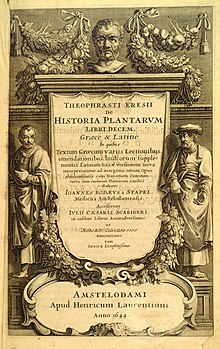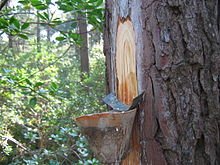Historia Plantarum (Theophrastus book)
 The frontispiece to an illustrated 1644 edition, Amsterdam | |
| Author | Theophrastus |
|---|---|
| Country | Ancient Greece |
| Subject | Botany |
Publication date | c. 350 BC – c. 287 BC |
| Pages | 10 books, 9 surviving |
Theophrastus's Enquiry into Plants or Historia Plantarum (Greek: Περὶ φυτῶν ἱστορία, Peri phyton historia) was, along with his mentor Aristotle's History of Animals, Pliny the Elder's Natural History and Dioscorides's De materia medica, one of the most important books of natural history written in ancient times, and like them it was influential in the Renaissance. Theophrastus looks at plant structure, reproduction and growth; the varieties of plant around the world; wood; wild and cultivated plants; and their uses. Book 9 in particular, on the medicinal uses of plants, is one of the first herbals, describing juices, gums and resins extracted from plants, and how to gather them.
Historia Plantarum was written some time between c. 350 BC and c. 287 BC in ten volumes, of which nine survive. In the book, Theophrastus described plants by their uses, and attempted a biological classification based on how plants reproduced, a first in the history of botany. He continually revised the manuscript, and it remained in an unfinished state on his death. The condensed style of the text, with its many lists of examples, indicate that Theophrastus used the manuscript as the working notes for lectures to his students, rather than intending it to be read as a book.
Historia Plantarum was first translated into Latin by Theodorus Gaza; the translation was published in 1483. Johannes Bodaeus published a frequently cited folio edition in Amsterdam in 1644, complete with commentaries and woodcut illustrations. The first English translation was made by Sir Arthur Hort and published in 1916.
Book
The Enquiry into Plants is in Hort's parallel text a book of some 400 pages of original Greek, consisting of about 100,000 words. It was originally organised into ten books, of which nine survive, though it is possible the surviving text represents all the material, rearranged into nine books rather than the original ten.
Theophrastus's two plant books have similar titles to two books on animals by his mentor Aristotle; Roger French concludes that he was effectively "doing a peripatetic exercise"[3] in identifying regularities in and differences between plants, in the manner of Aristotle with animals. However, he went beyond Aristotle in describing seeds as parts of the plant; Aristotle, French argues, would never have described semen or embryos as parts of an animal.[3]
Theophrastus made use of a variety of sources for the book, including
The surviving texts are the notes that Theophrastus used in teaching, and they were continually revised.[2] He referred to earlier books in the Lyceum library including Democritus, sometimes preserving fragments of books otherwise lost.[2] He mentions about 500 species of plant.[2]
Translations

The Enquiry into Plants (along with the Causes of Plants) was first translated into Latin by
A good and often-cited edition is that of Johannes Bodaeus, published in Amsterdam in 1644. This folio edition has the Greek and Latin texts printed in parallel, along with commentaries on the text by
The first translation into English, with an introduction and parallel Greek and English texts, was made by Sir Arthur Hort (1864–1935). It was published simultaneously by William Heinemann in London and G. P. Putnam's Sons in New York, as a two-volume book Theophrastus Enquiry into Plants and minor works on odours and weather signs in 1916.[7]
Three older German editions with commentaries are described by Hort as indispensable: Schneider and Link's 1818–1821 edition already mentioned; Kurt Polycarp Joachim Sprengel's 1822 edition from Halle; and Christian Friedrich Heinrich Wimmer's 1842 edition from Breslau.[8]
Contents
Enquiry into Plants classifies plants according to how they reproduce, their localities, their sizes, and their practical uses including as foods, juices, and herbs.[9]
The books describe the natural history of plants as follows:[10]
Book 1: Plant anatomy
Theophrastus tours plant anatomy, including leaves (phylla), flowers, catkins, fruits (karpoi), seeds, roots (rhizai), and wood.
Plants are classified as
Book 2: Tree and plant propagation

Theophrastus writes that plants can
Book 3: Wild trees
Theophrastus asserts that all wild trees grow from seed or from roots. He mentions that the
The book offers numerous examples of Theophrastus's note-like style, with lists of species interspersed among the general explanations. For example, "Now among wild trees those are evergreen which were mentioned before, silver-fir fir 'wild pine' box andrachne yew Phoenician cedar terebinth alaternus hybrid arbutus bay holm-oak holly cotoneaster kermes-oak tamarisk; but all the others shed their leaves ..."[12]
Book 4: Trees and shrubs from abroad
Theophrastus describes trees and shrubs from different places and habitats, as for instance a sheltered part of the Arcadia region near Krane in a deep valley where the sun never reaches, and the silver-fir trees are exceptionally tall. He looks into the plants of
. He also considers factors that limit the life of plants including diseases and weather damage.Book 5: Wood
Theophrastus describes the wood of different trees, the effects of climate on wood, of knots and 'coiling' in timber and other differences in quality. He discusses which woods to use for specific purposes such as for
Book 6: Undershrubs, with thorns or without
Theophrastus classifies undershrubs as spiny, such as
Book 7: Pot-herbs
Theophrastus reports that
Book 8: Cereals and legumes
Theophrastus groups together the
Book 9: Medicinal uses of plants

This book is one of the first
Drug collectors have certain traditions which may be accurate or may be exaggerated. Precautions are rightly taken when gathering hellebore, and men cannot dig it up for long; whereas the story that the peony must be dug up at night for fear that a woodpecker will watch and cause the man a rectal prolapse is a mere superstition. Similarly the idea that you must mark three circles around a mandrake plant with a sword, and speak of the mysteries of love while cutting it, is just far-fetched.
Apart from Greece itself, medicinal plants are produced in Italy in
Reception
Ancient
John Scarborough comments that "The list of herbals assembled in Historia Plantarum IX became the direct ancestor of all later drug treatises in antiquity, and many traces of Theophrastus's (and Diocles's) original observations survive in the Materia Medica of Dioscorides. The analysis of the various plants and plant derivatives shows that the Greek rhizotomoi and drug-vendors had collected much valuable information on the medical employment of plants, and Theophrastus invented a format for this type of information that would be followed after his own time."[4]
Mediaeval and Renaissance

Theophrastus was barely known to western Europe in the
Modern
The Chicago Botanic Garden describes Historia Plantarum as the "first great botanical work" of Theophrastus, "the first real botanist"; it states of the 1483 edition printed by Bartolomeo Confalonieri in Treviso that "all taxonomy of plants starts with this modest book", centuries before the modern taxonomy of Linnaeus.[19] Anna Pavord observes in her 2005 book The Naming of Names that Theophrastus made the first ever classification of plants, and Pliny the Elder, now much better known, used much of his material.[20]
See also
- On Plants
- Natural History (Pliny)
- De Materia Medica(Dioscorides)
Notes
References
- ^ Gotthelf 1988, p. 113.
- ^ a b c d e Thomas Fisher Rare Book Library 2014
- ^ a b c French 1994, pp. 92–99
- ^ a b c d Scarborough 1978, pp. 353–385
- ^ Hort 1916, p. ix, Introduction.
- ^ Hort 1916, p. xii, Introduction.
- ^ Theophrastus 1916.
- ^ Hort 1916, pp. xiii–xiv, Introduction.
- ^ Long 1842.
- ^ Sengbusch 2004
- ^ Theophrastus 1916, "Index of Plants", vol. II, p. 437.
- ^ Theophrastus 1916, p. 173 (3. III. 1-3).
- ^ Schmitt 1971, pp. 257–270
- ^ Hall 2011, p. 41.
- ^ Grafton, Most & Settis 2010, p. 146
- ^ Grafton, Most & Settis 2010, p. 626
- ^ Ogilvie 2008, p. 138.
- ^ Hort 1916, p. xv, Introduction.
- ^ Valauskas 2012.
- ^ Valauskas 2012, citing Pavord 2005, ch. 1 In the Beginning, which begins "Theophrastus is the first in the long list of men who fought to find the order they believed must exist in the dizzying variety of the natural world. ... Theophrastus knew about 500 [plant species]"; ch. 4 Pliny the Plagiarist
Bibliography
Text
- Theophrastus (1916). Theophrastus: Enquiry into Plants. Loeb Classical Library. Translated by Hort, Arthur. London and New York: William Heinemann and G.P. Putnam's Sons. (available at Internet Archive as Volume I (Books I–V) and Volume II (Books VI–IX & minor works) )
- Hort, Arthur. Introduction. In Theophrastus (1916), pp. ix–xxiii.
- Gaza, Theodorus; Scaliger, Iulius Caesar; Bodaeus, Johannes; Corvinus, Johannes Arnoldus; Bodaeus, Egbertus; Constantin, Robert (1644). Theophrasti Eresii De historia plantarum libri decem, Graecè & Latinè. In quibus textum Graecum variis lectionibus, emendationibus, hiulcorum supplementis; Latinam Gazae versionem nova interpretatione ad margines ... item rariorum plantarum iconibus illustravit Ioannes Bodaeus à Stapel ... Accesserunt Iulii Caesaris Scaligeri in eosdem libros animadversiones; et Roberti Constantini annotationes .(in Latin and Greek). Amsterdam: Judoci Broers.
Commentary
- Einarson, Benedict (January 1976). "The Manuscripts of Theophrastus' Historia Plantarum". Classical Philology. 71 (1): 67–76. S2CID 162094717.
- Thomas Fisher Rare Book Library (2014). "Theophrastus and the nature of plants". University of Toronto. Archived from the original on 2 June 2014. Retrieved 2 June 2014.
- French, Roger (1994). Ancient Natural History: Histories of Nature. Routledge. pp. 92–99. ISBN 0-415-11545-0.
- Gotthelf, Allan (1988). Fortenbaugh, William Wall; Sharples, Robert W. (eds.). Historiae I: plantarum et animalium. Transaction Publishers. )
- Grafton, Anthony; Most, Glenn W.; Settis, Salvatore, eds. (2010). The Classical Tradition. Harvard University Press. ISBN 9780674035720.
- Hall, Matthew (2011). Plants as Persons: A Philosophical Botany. SUNY Press. ISBN 9781438434308.
- Long, George, ed. (1842). "Theophrastus". Penny Cyclopaedia of the Society for the Diffusion of Useful Knowledge. Vol. 24. pp. 332–334.
- Ogilvie, Brian W. (2008). The Science of Describing: Natural History in Renaissance Europe. University of Chicago Press. ISBN 9780226620862.
- ISBN 978-1-59691-071-3.
- Scarborough, John (1978). "Theophrastus on Herbals and Herbal Remedies". Journal of the History of Biology. 11 (2): 353–385. S2CID 44616422.
- Schmitt, Charles B. (1971). "Theophrastus in the Middle Ages". Viator. 2: 257–270.
- Sengbusch, Peter V. (2004). "First Scientific Descriptions". University of Hamburg. Archived from the original on 9 May 2014. Retrieved 2 June 2014.
- Valauskas, Edward J. (December 2012). "Theophrastus and the beginnings of modern botany in the Renaissance". Chicago Botanic Garden. Retrieved 27 July 2015.
External links
- Texts
- Enquiry into Plants (Hort). Books 1 to 5 (parallel text, Greek and English)
- Enquiry into Plants (Hort). Books 6 to 9 (parallel text, Greek and English)
- De Historia Plantarum. Book 1. (in Latin)
- Enquiry into Plants. Book 1 (trans. Emile Egger and Eugene Fournier: in French)
- Images and descriptions
- Chicago Botanic Garden: Theophrastus and the beginnings of modern botany in the Renaissance
- Edward Worth Library: Theophrastus of Eresus

